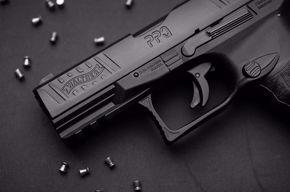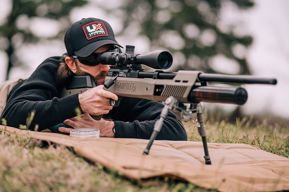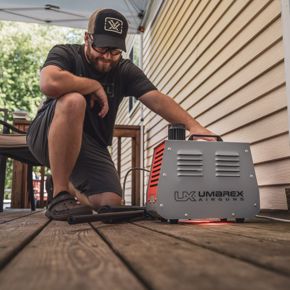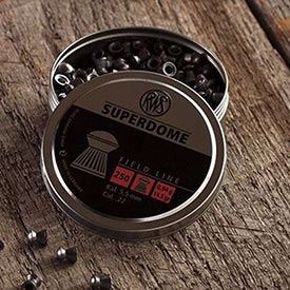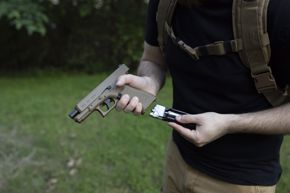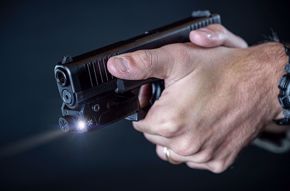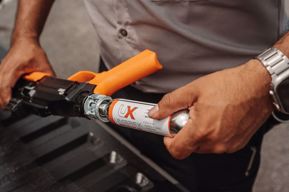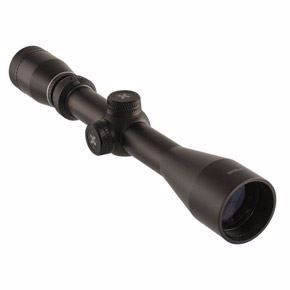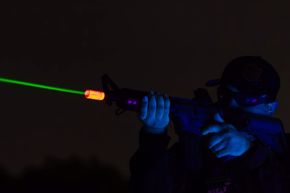Most of the reviews that I write feature new products from firearms manufacturers. It is rare that I get to go back and spend quality time with the classics. Enough has been written about them that most of what I will say may seem redundant. But the Model 34 is a classic. And since this rifle is new to me, I’m going to assume it might be new to you, too.
The Model 34 is a solid workhorse but manages to maintain the graceful lines of classic sporting guns. The hardwood stock is very well made. The receiver has clean lines and strong bluing. The tolerances on this gun are very tight. From the smallest details (like the fiber optics in the sights) down to the classic feel of the hard butt pad in your shoulder, the Model 34 is a well-built gun.
Even its internals speak to time-honored traditions. This is a spring-powered air rifle. As such it can be a bit jumpy. Spring powered air rifles, especially the strong ones, tend to flex as the recoil impulse of the moving spring shifts forward. I found I had the best results from the Model 34 by bracing the rifle firmly in my shoulder and resting the stock on the palm of my open hand.
And while we are talking about accuracy, I will say that the results are spot on. From 30 yards with the open sights, I could put down a five shot group that I could easily cover with a half-dollar. That’s not bad shooting when you consider that in between every shot you have to muscle down the spring again.
The Model 34 has a true two-stage trigger. It is adjustable and comes set to break at just over 3 pounds. If you want it lighter, you can dial it back.
The Model 34 makes excellent use of the length of its barrel. The front sight is down at the muzzle, obviously. The rear sight is mounted just above the break action. While this limits the sight radius that would otherwise be available down the rest of the stock, it allows for a rock-solid, stable platform that never shifts. The rigidity of the barrel keeps the front and rear sight in constant alignment.
For those who would rather not rely on iron sights, the Model 34 is also available with a scope. The Model 34’s accuracy provides for rewarding plinking, and it is more than sufficient for hunting small game, so a scope is a logical addition. The scope included with the rifles is a 4x32. (RWS 34 w/Scope)
While I look at the Model 34 as a serviceable field gun, its inherent accuracy and its adjustable trigger make it capable for target shooting, also.
If there was one feature of the Model 34 that really stood out for me, it was its size. I’m tall, and many air guns seem built for an intermediate sized shooter. The length of pull on the Model 34 is about what I would expect from an off-the-shelf centerfire, or some of the larger rimfires from the middle of the 20th Century—almost 14 inches.
The Model 34 is available in either .22 or .177 pellets. While you see a slight drop off in speed with the .22, the harder hit of your pellets make up for it. The spring power itself requires 33 pounds of pressure to cock give or take. If you are working it fast, in rapid succession, you’ll feel it the next day. Yet the length of the barrel itself coming in at 19.5 inches, allows for much more leverage on the spring then you get with smaller rifles. And that 33 pounds of pressure translates into tremendous velocity when you pull the trigger.
The Model 34 is a classic. It says so on the receiver. But it is more than that. With proper maintenance and care, the Model 34 is a classic you’ll pass down like you would an old Winchester.
The safety on the Model 34 is a very interesting design. If the gun is cocked, the safety can be moved off and on. If it has been fired, the safety will only remain in the fired position. As you move the break action, the safety automatically engages. So if you’re not sure if it is cocked, you can easily tell by using the safety.
What I find most compelling about the safety’s design is that you can see in your peripheral vision as you look down the sights if the safety is on or off. If it is on, a white dot appears. If the gun is ready to fire, only the red dot is visible. This is very hard to explain to anyone who hasn’t looked down the barrel, but the state of the safety is actually quite easy to determine. And the placement of the safety on top of the tank allows you to reach up with your thumb without having to reposition your shooting hand.
The Model 34 is a great example of why people marvel at German engineering. And it sells for less than $325.
David Higginbotham is a writer and educator who lives in Arkansas. After years of writing and consulting in the firearms industry, he's coming back to his roots with air guns.

